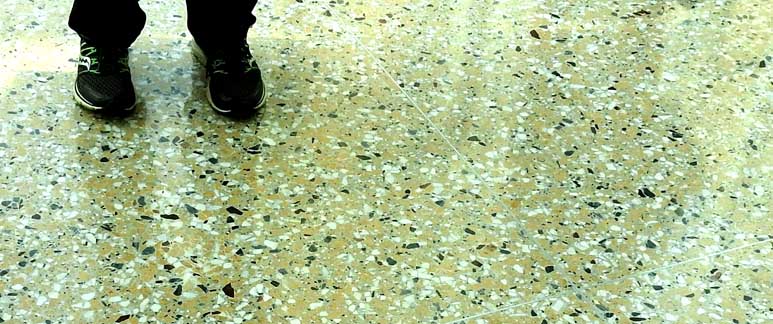Building materils .............
![]()
Building materils .............
Building materials .....................Illustrated Architecture Dictionary ..................... Illustrated FURNITURE Glossary
Terrazzo

| Origin: Early 20th
century: Italian, literally ‘terrace,’ based on Latin terra ‘earth’ |
| Terrazzo
is
a faux-marble flooring or countertopping material, made up of small
chips of stone that are set hard in a binding material and then ground
over until completely level. Marble-chip, cementitious terrazzo requires three layers of materials.
Terrazzo was originally invented by Venetian construction workers as a low cost flooring material using marble chips from upscale jobs. The workers would usually set them in clay to surface the patios around their living quarters. Consisting originally of marble chips, clay, and goat milk (as the sealer), production of terrazzo became much easier after the 1920s and the introduction of electric industrial grinders and other power equipment. Today, most of the terrazzo installed is epoxy terrazzo - Wikipedia (April 2011)
|
| Terrazzo
-
chips of marble, glass or other aggregates embedded in tinted cement,
ground smooth and polished to a silky sheen—may have been yet another
of mankind's accidental discoveries. In the 15th century, mosaic
artisans in northern Italy swept waste marble chips out onto their
terraces, terrazzi, and smoothed the surface simply by walking over it.
When workers learned to press the chips into a more permanent clay
base, then grind and polish them with heavy stones, terrazzo caught on.
Michelangelo used it in St. Peter's Basilica. George Washington strode over it in his cherished Mount Vernon. In the 1950s, Richard Neutra and other modernist architects specified terrazzo in their designs, and by the '60s, it covered floors in developer houses across the Southeast and Southwest. - Jack McClintock, This
Old House magazine (April 2011)
|
| Invented
by the Romans, terrazzo
was reintroduced in commercial settings in the 1920s, segued to
high-end homes like the designs of Richard Neutra in the 1940s, and
became the indoor-outdoor flooring of choice in homes from Florida to
California during the 1960s. Terrazzo is a blend of aggregate - stone or marble chips - embedded inc cast or poured concrete or cement. Once installed, terrazzo can last for decades with proper care. Terrazzo is traditionally composed of two parts aggregate to one part Portland cement, bound together with just enough water to bring the mixture to a cookie-dough consistency. Once leveled in place, additional stone chips are sprinkled over the surface to create a uniform appearance [min 70% aggregate]. As a final touch, the surface should be sealed with a commercial penetrating sealer formulated specially for terrazzo. Provided the floor is not structurally compromised, it can be brought back to its original luster with a good machine polishing and buffing, which will remove the old sealer and any paint or glue. - Old House Journal, April 1, 2017 |
Examples from Buffalo: